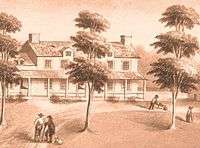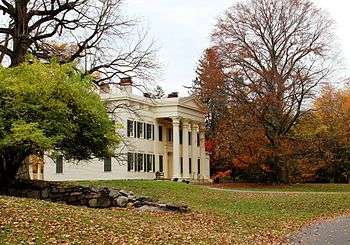1838 Peter Augustus Jay House
|
1838 Peter Augustus Jay House | |
|
The Jay Estate in Rye, NY | |
| Location | Rye, New York |
|---|---|
| Built | 1838 |
| Architect | Edwin Bishop with influences by Minard Lafever, Asher Benjamin and Chester Hills |
| Architectural style | Greek Revival |
| Part of | Boston Post Road Historic District (Rye, New York) (#82001275[1]) |
| Significant dates | |
| Added to NRHP | October 29, 1982[1] |
| Designated NHLDCP | August 30, 1993[2] |
The 1838 Peter Augustus Jay House and surrounding 23-acre (9.3 ha) Jay Estate [3] form the centerpiece of the Boston Post Road Historic District of Rye, New York.[4] The site is the surviving remnant of the 400-acre (1.6 km2) farm where one of America's seven Founding Fathers,[5] John Jay (December 12, 1745 – May 17, 1829), grew up and where he also returned to celebrate the end of the Revolutionary War.[6] The preserved property is located on the south side of the Boston Post Road (US 1) in Rye and has a 3⁄4-mile (1.2 km) view of Milton Harbor. It overlooks a 10,000+ year old Paleo-Indian archaeological site[7] and the oldest man-managed meadow on record in New York State.
The house and its landscape are the keystones of a National Historic Landmark District (NHL) created in 1993.[2][8]
Location and significance
.jpg)

Of America's seven founders, Jay alone was a native of New York State. He was raised in Rye from infancy at a country seat called "The Locusts" overlooking Long Island Sound. He returned there frequently throughout his illustrious career for important family gatherings most famously a celebration of his role as one of the three American peace commissioners who negotiated the Treaty of Paris.[6]
Jay inherited the entire property outright in 1813 and conveyed it nine years later in 1822 to his eldest son Peter Augustus Jay. Seven years after his father's death, Peter reluctantly took down the ancestral house but reincorporated its timbers, doors, shutters and nails into a new 1838 structure, locating the second construction on the footprint of the first building. Stylistic elements appear to have been influenced by architectural pattern books by Minard Lafever, Asher Benjamin and Chester Hills.[9] While the style of the mansion's facade is grand, the rear piazza replicates the simplicity and same dimensions of the first house, one story high and 80 feet (24 m) long.[6]
Upon seeing the preserved landscape and viewshed of John Jay's youth and early adulthood, Justice Harry Blackmun remarked,[10]
"It was a place that struck me then as symbolic of what was impressive about certain aspects of the latter part of the 18th century—gracious living and status to be sure, but coupled with a sense of responsibility, particularly to government and to the art of getting along together."— Harry Blackmun, Associate Justice, United States Supreme Court
The Jay mansion has been recognized as an outstandingly pure example of Greek Revival architecture.
"The [1838] Peter Jay House...is undeniably a major architectural landmark. This monumental Greek Revival style house has been generally recognized as one of the most important buildings of its type in the country. Its symmetrical massing, bold scale, and grandly austere detail are an extraordinary symbol of the increasing wealth and power of America during the decade of the 1830s. The house also reflects the importance of the Jay family in a maturing nation."— Andrew Dolkart, architectural historian
Historic preservation and interpretation

The Jay Heritage Center owns the 1838 Peter Augustus Jay House. Pieces of the original 18th century house "The Locusts" found within the mansion are also on public view and illustrate sustainable building traditions.[11] JHC uses the house to host programs in American History, Architecture, Landscape Conservation and Environmental Stewardship. The building is an official Save America's Treasures project.
In November 2008, the PAJ House became the oldest National Historic Landmark structure in New York State to be equipped with an energy-efficient geothermal heating and cooling system.[12] The Jay Estate was designated a member site of the Hudson River Valley National Heritage Area (HRVNHA)[13] in January 2009, based on its architectural and historic significance as well as green management practices and design efforts in sustainability. The HRVNHA is a prestigious designation by the National Parks System (NPS).
African-American Heritage Trail and NY State Path Through History
John Jay is well known for advocating emancipation, serving as the first President of the New York Manumission Society, and establishing the first African Free School. His son Peter Augustus Jay also served as President of the Manumission Society, continuing his work. The family's home has been designated one of 13 sites on the Westchester County African-American Heritage Trail.[14] In 2013, it was added to New York State's Path Through History as an important site that explores themes and the evolution of Civil Rights.[15] It is open to schools and to the public.
References
- 1 2 National Park Service (2007-01-23). "National Register Information System". National Register of Historic Places. National Park Service.
- 1 2 "Boston Post Road Historic District". National Historic Landmark summary listing. National Park Service. 2007-09-14.
- ↑ Clement, Douglas P. (13 March 2016). "At the Jay Heritage Center in Rye: Young Americans". The New York Times.
- ↑ Herbert Alan Johnson, "John Jay 1745-1829" (The University of the State of New York, The State Education Department, 3d edition, Revised in 1995 to Commemorate the 250th Anniversary of the Birth of John Jay, Born December 12, 1745, p.57.)
- ↑ Richard B. Morris, Seven Who Shaped Our Destiny: The Founding Fathers as Revolutionaries (New York: Harper & Row, 1973)
- 1 2 3 Hubbard, Elbert, "John Jay," Magazine of American History, New York, January, February, March Issue 1902, p.27.
- ↑ Pfeiffer, John, "Preliminary Archaeological Survey of the Boston Post Road Historic District of Rye, NY," April 21, 1982. p. 2
- ↑ Karen Kennedy; Austin O'Brien (December 12, 1986). "National Register of Historic Places Inventory-Nomination: Boston Post Road Historic District" (pdf). National Park Service. and Accompanying 33 photos, exteriors and interiors, from 1979-1983. (7.94 MB)
- ↑ Kennedy & O'Brien 1986, p. 13.
- ↑ Justice Harry A. Blackmun, "John Jay and the Federalist Papers," Pace Law Review, 1988
- ↑ Berger, Joseph (2 March 2008). "What's a Historic House You Can't Enter in Style?". The New York Times.
- ↑ Lowey, Hon. Nita, Jay Heritage Center to Become Energy Efficient, August 8, 2008.
- ↑ Hudson River Valley National Heritage Area, Jay Heritage Center
- ↑ African American Heritage Trail Brochure, Westchester County.
- ↑ New York State Path Through History, Civil Rights Planned Itinerary
Sources
- Jay, John. Memorials of Peter A. Jay 1905. G.J. Thieme.
- Wells, Laura Jay The Jay Family of La Rochelle and New York, 1938. Order of Colonial Lords of Manors in America.
- Morris, Richard B. Seven Who Shaped Our Destiny: The Founding Fathers as Revolutionaries (New York: Harper & Row, 1973).
- Pfeiffer, John "Preliminary Archaeological Survey of the Boston Post Road Historic District of Rye, NY," April 21, 1982.
- The Modern Builder's Guide, 1833.
- The Beauties of Modern Architecture, 1835.
- Johnson, Herbert Alan, John Jay 1745-1829, 3d Edition, 1995. The University of the State of New York, The State Education Department.
External links
- Jay Heritage Center - Official site
- New York State Historic Sites: Jay Heritage Center
- Library of Congress - Local Legacies - Jay Heritage Center
- The Papers of John Jay, an image database and indexing tool comprising 13,000 documents from the Rare Book & Manuscript Library at Columbia University and approximately 90 other institutions
Coordinates: 40°57′31″N 73°42′07″W / 40.958487°N 73.701922°W


